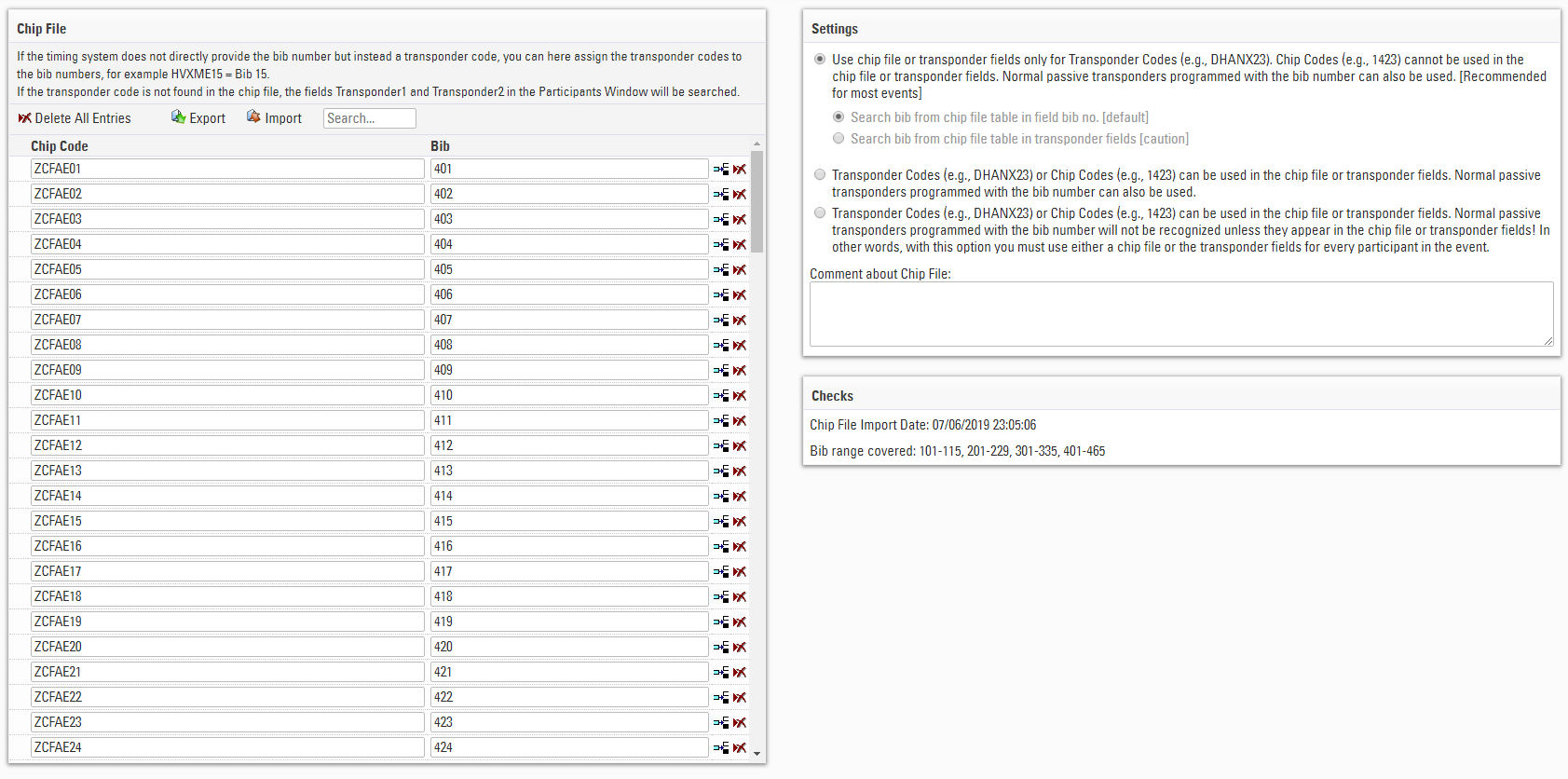Los transpondedores desechables de RACE RESULT como el Número de Carrera con Chip están programados con el número del dorsal. En otras palabras, el número del chip (o código del chip) es el mismo que el del dorsal. En este caso, no necesita un archivo de chip!
Sin embargo, si trabaja con transpondedores reutilizables como el HuTag RACE RESULT o el Transpondedor ActivePro debe asignar códigos de chip a los números de dorsal. Un Archivo de Chip se puede ingresar o importar en Ventana Principal -> Archivo de Chip. Simplemente ingrese el Código de Chip y Número de Dorsal en el recuadro.
Un archivo de chip se puede importar desde un archivo de Excel, TXT o CSV con los números de dorsal y códigos de chip correspondientes.
También puede buscar el archivo de chip con el Código de Chip o Dorsal para buscar participantes específicos.
Si está utilizando transpondedores pasivos con un archivo de chip y necesita asignar un número diferente de chip y dorsal, debe prestar atención a la Configuración de Archivo de Chip. También puede crear una asignación de dos pasos para los transpondedores que estén pre-etiquetados pero en los cuales la etiqueta del chip no es necesariamente igual al número de babero.

Chip File Settings
There are 3 options for Chip File settings which affect how the chip file or Transponder1 / Transponder 2 fields are used.
"Use chip file or transponder fields only for Transponder Codes (e.g., DHANX23). Chip Codes (e.g., 1423) cannot be used in the chip file or transponder fields. Normal passive transponders programmed with the bib number can also be used. [Recommended for most events]"
This is the most common option, it allows you to use Transponders with alpha-numeric codes (Active Transponders, HuTags, Reusable ShoeTags or A-Z Transponders) or assumes that if a numerical chip code is received then Chip Number = Bib Number.
Below this are 2 options for how transponder codes are then mapped to a participant.
"Search bib from chip file table in field bib no. [default]" - The bib number in the chip file table will be matched against the bib field of the participants.
Chip Code -> Bib Number
(for example: ZDXED44 -> 44)
Alternatively, you can create a two-step mapping using "Search bib from chip file table in transponder fields [caution]"
Chip Code -> Chip Number -> Bib Number
(for example: ZDXED44 -> 744 -> 44)
The chip ZDXED44 has a sticker with its chip number 744. ZDXED44 and 744 will be entered in the chip file table. In the participants Transponder 1 or Transponder 2 field the chip number should be entered. In the example above, bib number 44 has chip number 744.
The main advantage is that you can more easily assign chip numbers to participants. Instead of handling complex chip codes such as ZDXED44, you only need to enter 744.
"Transponder Codes (e.g., DHANX23) or Chip Codes (e.g. 1423) can be used in the chip file or transponder fields. Normal passive transponders programmed with the bib number can also be used."
In this mode you can use transponders with alpha-numeric codes, and can also map non-matching bib and chip codes. In this mode if a passive transponder with a chip number is scanned it is first checked against the chip file, and assigned to the corresponding bib, if there is no mapping for this chip to a bib then it is assumed that for this chip the Chip Number = Bib Number.
"Transponder Codes (e.g., DHANX23) or Chip Codes (e.g., 1423) can be used in the chip file or transponder fields. Normal passive transponders programmed with the bib number will not be recognized unless they appear in the chip file or transponder fields! In other words, with this option you must use either a chip file or the transponder fields for every participant in the event."
In this mode you can use transponders with alpha-numeric codes, but if you use normal passive transponders then the chip code must be mapped to a bib number. Any chips which are not allocated in the chip file or transponder fields will be treated as unknown transponders.